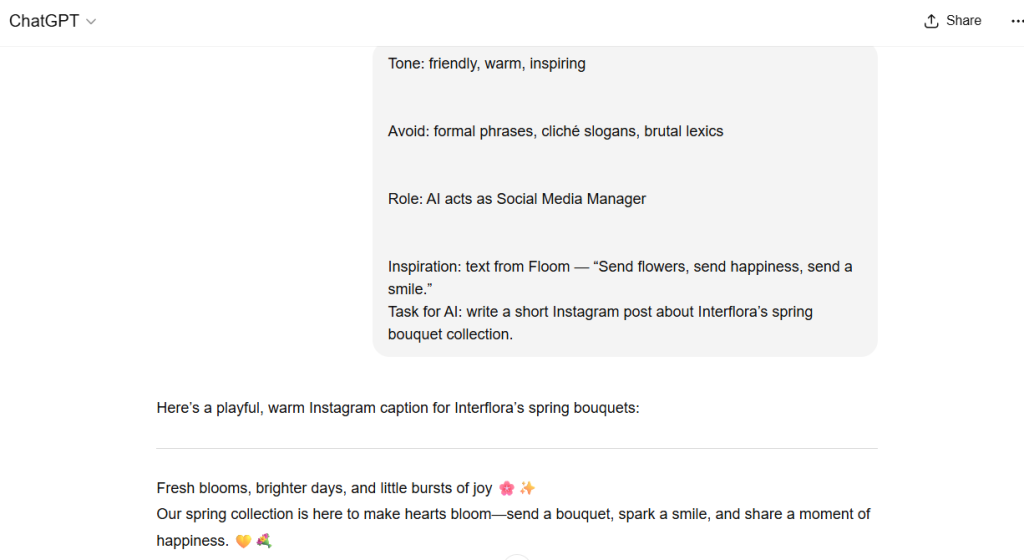Everyone’s talking about automating content. But no one talks about how to keep your brand’s voice when AI is the one doing the writing.
Your businesses spend years shaping a tone of voice that people instantly recognize and actually connect with. But once you plug in a generative model, everything starts sounding average, flat, and soulless.
So, how to train AI model for brand voice? That’s exactly what we’re diving into because this isn’t magic, it’s strategy. Let’s get started!

Oct 24, 2025 • 6 min read
Why Your Brand Voice Is Important
Before using brand voice AI, it’s important to understand why your brand voice matters.
Imagine a youth clothing brand with a friendly, playful, and slightly rebellious tone.
You can see this voice come to life across different types of content:
- Social media post: “Who said Mondays are boring? Put on your sneakers and go!”
- Email newsletter: “Your favorite new arrivals are here. Don’t miss out!”
- Product description: “This jacket will survive any rain and still keep you looking stylish.”
Across all channels, the brand sounds the same: the same youthful slang, style, and personality. This is the brand voice that makes the brand recognizable and easy to understand for the audience.
Here’s why having a brand voice matters:
- Make your brand easy to spot. People recognize your content right away.
- Build trust. A steady, familiar tone shows you’re reliable.
- Show who your brand is. Your content reflects your values and personality.
- Stand out from the crowd. A unique voice helps people remember you.
- Keep a consistent feel everywhere. From social posts to product pages, your brand sounds like itself.
Training AI To Speak In Your Brand Voice
To get your brand voice in AI-generated content right, you need to teach AI how you actually sound. Left on its own, it won’t know what makes you unique and will just spit out generic text. And it’s actually pretty simple to fix in just a few steps.
1. Define Your Brand Voice
The first step is to understand exactly how your brand sounds. Choose your tone, style, and values:
- Tone: friendly, professional, playful
- Style: short sentences, simple words
- Values: trust, transparency, humanity
Your brand might sound different from the example, depending on who you’re talking to and what you want to say. The main thing is to clearly decide all the details.
2. Create a Brand Voice Guide for Your LLM
Next, put all your brand rules into one prompt for the AI. Note and include everything you’ve already decided for your brand, such as:
- What tone should your texts have
- Which words to use and which to avoid
- Basic style and structure guidelines
With clear rules, the AI can write in your style without sounding generic or flat.
3. Use Persona-Driven Prompting
Now you need to give the AI a specific role so it understands how to “speak” in your brand. This helps the model create texts more accurately and in the right context.
Examples of roles and prompts:
- “Act as our Social Media Manager. Write a playful Instagram caption for our new sneakers.”
- “Act as our Customer Support agent. Answer a question about shipping in a friendly tone.”
4. Give Examples of the Expected Output
Show the AI what a good text should look like. Just copy them from any source you like and include these examples in your prompt.
- Example of an Instagram post: “Who said Mondays are boring? Put on your sneakers — and go!”
- Example of a product description: “This jacket will survive any rain and still keep you looking stylish.”
5. Bring Your Brand Voice To Life
Now the AI follows your rules, examples, and roles to write content. Review what it creates, tweak the prompts, and update your guide so your brand voice stays clear in every channel. You have unlimited attempts, so don’t stop and don’t accept the text if it doesn’t feel right.

Example
Let’s imagine we are writing for the Interflora marketing team. Our goal is to create Instagram posts to showcase our spring bouquet collection and convey a warm, friendly brand tone.

- Create the AI prompt
Include all important details such as tone, words to avoid, AI’s role, and an example text for inspiration:
- Tone: friendly, warm, inspiring
- Avoid: formal phrases, cliché slogans, harsh or overly strong words
- Role: act as Social Media Manager
- Inspiration: text from Floom — “Send flowers, send happiness, send a smile.”
- Task for AI: generate a short Instagram post about Interflora’s spring bouquet collection.
- AI-generated result
“Fresh blooms, brighter days, and little bursts of joy 🌸✨
Our spring collection is here to make hearts bloom — send a bouquet, spark a smile, and share a moment of happiness. 💛💐”

- Adjustments and final result
We shorten the sentence a bit, add emojis, and make the text lighter and more lively.
Final text:
“Blooms, smiles, and sunny vibes 🌸☀️💛
Our spring bouquets are here to brighten someone’s day — send a little joy! 💐✨”
Why Human Touch Is Still Necessary
Even with a working AI brand voice, people still need to stay involved. AI writes quickly and keeps a steady style, but it lacks genuine emotion, so you may notice parts that don’t feel right.
When to step in:
- Make the text match your brand.
- Fix unclear or awkward phrases.
- Add warmth and personality to the writing.
- Correct the AI so it learns your voice better.
This way, humans and AI work together: AI handles speed, and humans keep the content alive, emotional, and true to the platform.
Conclusion
Now you know how to train AI to understand brand tone. Sure, Generative AI writes super fast, but you still need to step in to add feeling, fix punctuation, and make the text easy to read.
Short on time? Use Smodin to test, refine, and align AI-generated texts with your brand’s tone. You can check them online, tweak grammar, and add your own touches if something comes to mind.
Start now and let your brand speak the way you want.


 AI
Plagiarism Checker
AI
Plagiarism Checker
 AI
Content Detection Remover
AI
Content Detection Remover
